Tuesday Aug. 28, 2007
We'll finish up air pollutants today. What we aren't able to
cover in class will be added to today's online notes. we
will begin the middle
portion of Chapter 1 on Thursday. that deals with the vertical
structure of the
atmosphere (changes of air pressure, air temperature, and air density
with altitude). Some new reading
was assigned.
The remaining Expt. #1 kits have been
checked out. If you are
signed up to do Expt. #1 you will now have to wait until students begin
to return the materials that they have checked out (some additional
materials have also been ordered and should arrive soon). If you
have
your materials please start the experiment as soon as you can
so that
you can return the materials for someone else to use.
At least one student in class needs a note-taker. If you feel you
take clear, complete, concise notes and are willing to share a copy
with a student with a disability, please come see me at the beginning
or end of class. You will be provided with carbonless copy paper
to take notes and will be formally recognized through a letter of
volunteer service for your porfolio or resume.
Carbon
monoxide is the most abundant of the air pollutants we will cover.
Some basic information about carbon monoxide is shown below (p. 7 in
the photocopied Class Notes). You'll find
additional information at the Pima
County Department of
Environmental Quality website and also at the US Environmental Protection Agency
website.
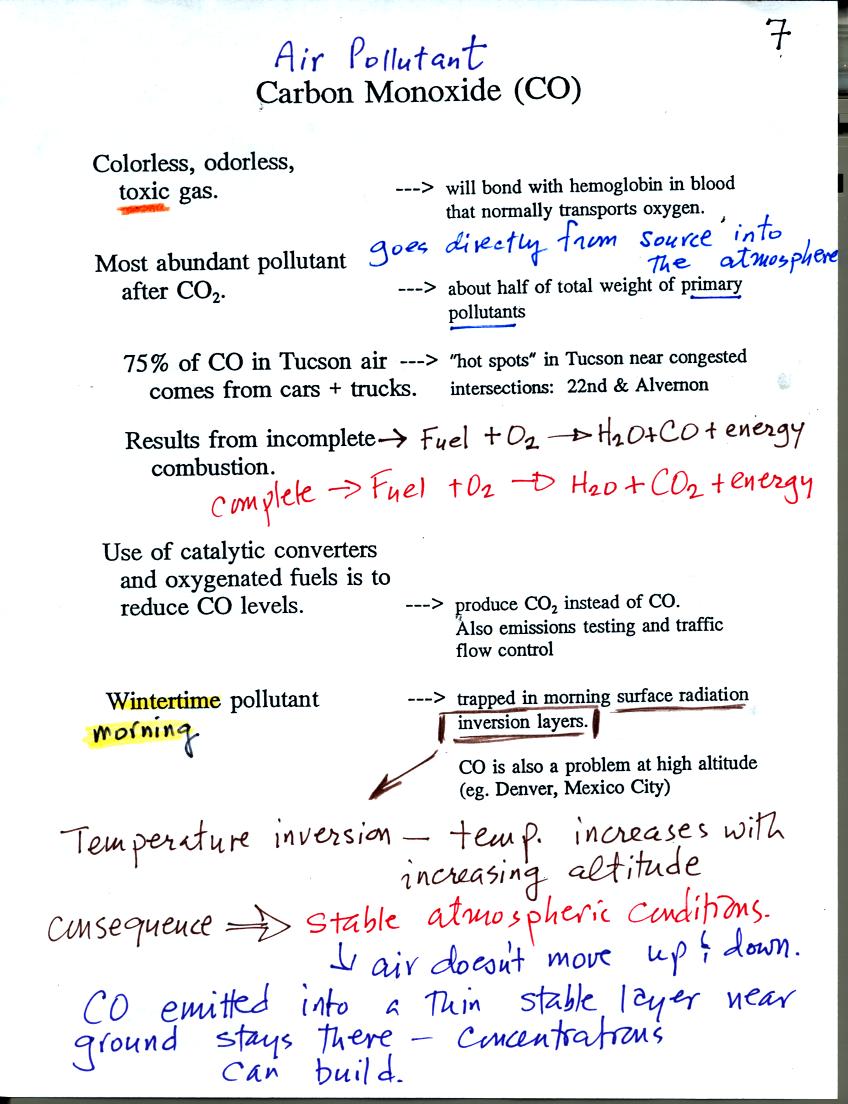
Carbon monoxide molecules bond strongly to the hemoglobin
molecules in
blood and interfere with the transport of oxygen through your
body. CO is a primary pollutant. That means it goes
directly from a source into the air (nitric oxide, NO, and sulfur
dioxide, SO2, are also primary pollutants). CO is
emitted directly from an automobile tailpipe into the atmosphere for
example
CO is produced by incomplete combustion of fossil
fuel. Complete combustion would produce carbon dioxide,
CO2. Cars and trucks produce much of the CO in
the
atmosphere. Vehicles must now be fitted with a catalytic
converter which will change CO into CO2 (and also NO into N2
and
O2). In Pima County vehicles must pass an emissions
test every
year and special formulations of gasoline (oxygenated fuels) are used
during the winter months to try to reduce CO emissions. See if
you can figure out why carbon monoxide is often a problem in cities at
high altitude (the answer is found at the bottom of today's online
notes)
Carbon monoxide is also a serious hazard indoors.
Because it is odorless, concentrations can build to dangerous levels
without you being aware of it. You can purchase a carbon monoxide
alarm that will monitor CO concentrations indoors and warn you when
concentrations reach hazardous levels. Indoors CO is
produced by gas furnaces and water heaters that are
either operating improperly or aren't being adequately vented
outdoors. Many people are killed indoors by carbon monoxide every
year. You can learn
more about carbon monoxide hazards and risk prevention at the Consumer Product
Safety Commission web page.
In the atmosphere CO concentrations peak on winter mornings.
Surface temperature inversion layers form on long winter night when the
ground becomes colder than the air above. Air in contact with the
cold ground cools and ends up colder than air above. Air
temperature increases with increasing altitude in a temperature
inversion and this produces a very stable layer of air at ground level.

The figure above wasn't
shown in class.
When CO is emitted into a thin stable layer (left figure above), the CO
remains in the layer and doesn't mix with cleaner air above. CO
concentrations build.
In the afternoon the atmosphere becomes more unstable. CO emitted
into air at the surface mixes with cleaner air above. The CO
concentrations are effectively diluted and don't get as high as they do
in the morning.
A portion of a time lapse cloud move was shown at the end of
class. Thunderstorms were developing over the Catalina
mountains. Thunderstorms are a visible indication of unstable
atmospheric conditions. The
figure below wasn't shown in class either.
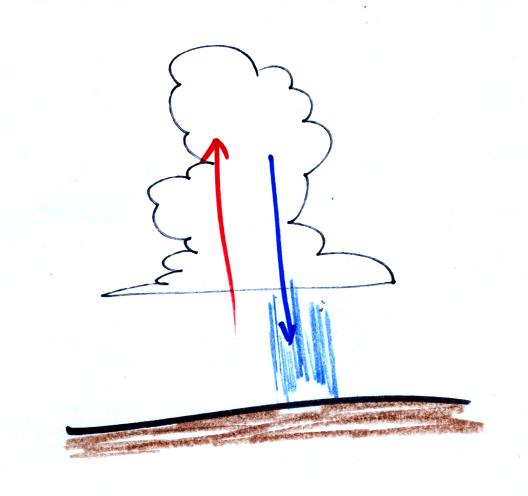
You could see the clouds growing vertically in the movie,
evidence of
rising air motions. Falling precipitation also produces a
downdraft that contains sinking air. This downdraft is the source
of
the strong, often damaging, surface winds that accompany thunderstorms.
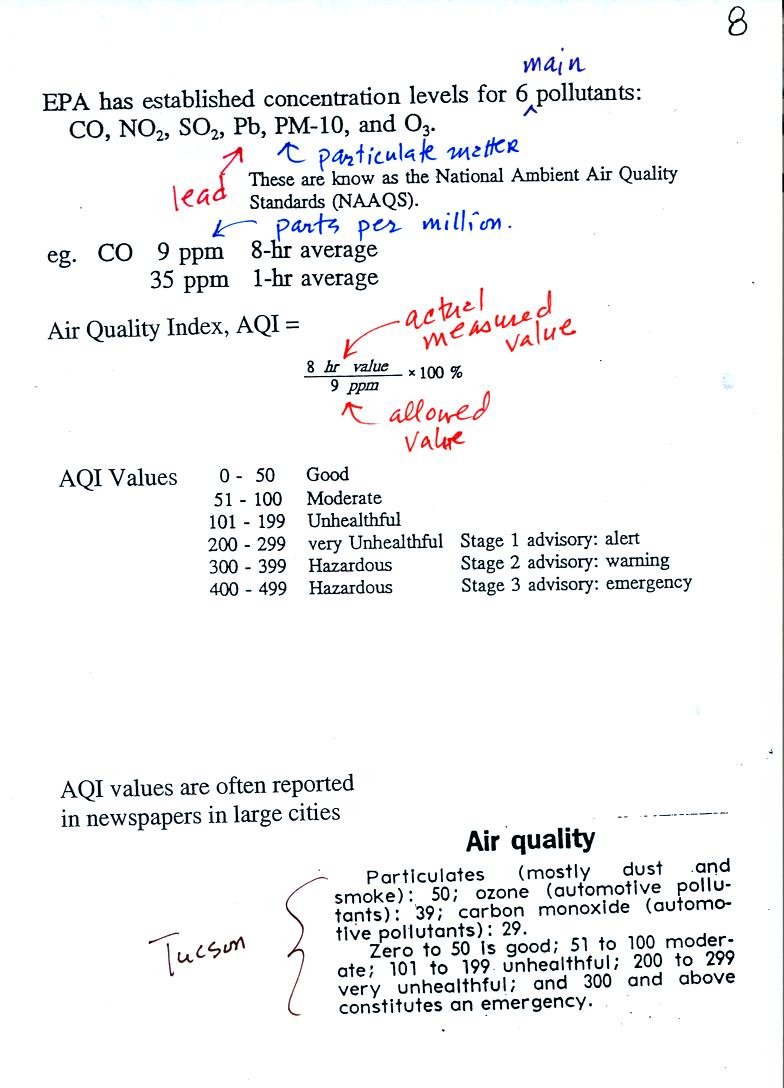
Six main pollutants are listed at the top of this page.
Concentrations of some or all of these pollutants are monitored
throughout the day in
many
cities. The atmospheric concentration of lead has decreased
significantly since the introduction of unleaded gasoline. PM
stands for particulate matter. These small particles are
invisible, remain suspended in the air, and may be made of harmful
materials..
CO, O3 and particulate matter are the pollutants of most
concern in
Tucson and pollutant concentrations are reported in the newspaper or on
television using the Air Quality Index (formerly the pollutant
standards index). This is basically the measured value divided by
the allowed value multiplied by 100%. Current Air Quality Index values for
Tucson are available online.
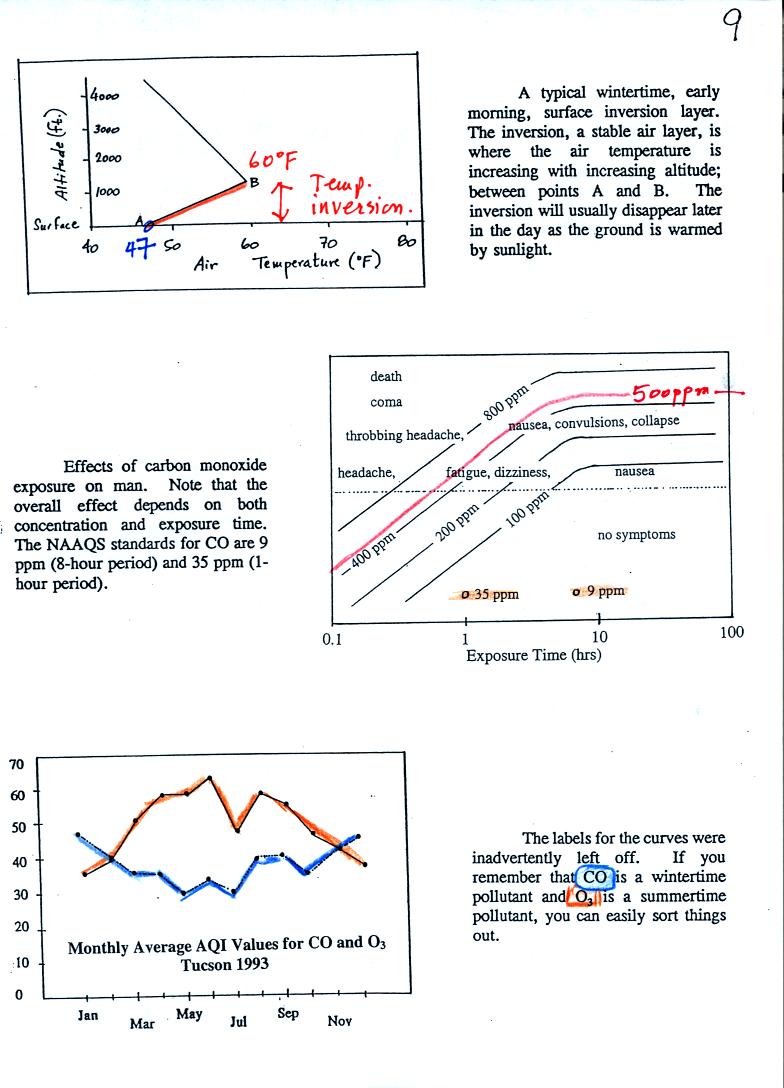
The first graphs shows a typical atmospheric temperature
profile
near the ground in the winter. The inversion is the bottom
portion of the plot where temperature increases from 47 F to near
60 F with 1000 feet of altitude gain. The 1000 foot deep
layer is a stable layer.
The middle figure shows some of the health effets and symptoms of CO
poisoning. The effect of CO depends on both the concentration and
the length of exposure. The NAAQS values are shown at
bottom of the chart. Exposure to CO concentrations of these
levels shouldn't cause any symptons in a healthy individual.
Concentrations reached 500 ppm in the apartment building near the
campus of Virginia Tech. Several students were discovered
unconcious.
The bottom figure shows average monthly AQI values for CO and O3
in
Tucson. CO concentrations (blue curve) tend to peak on winter
mornings.
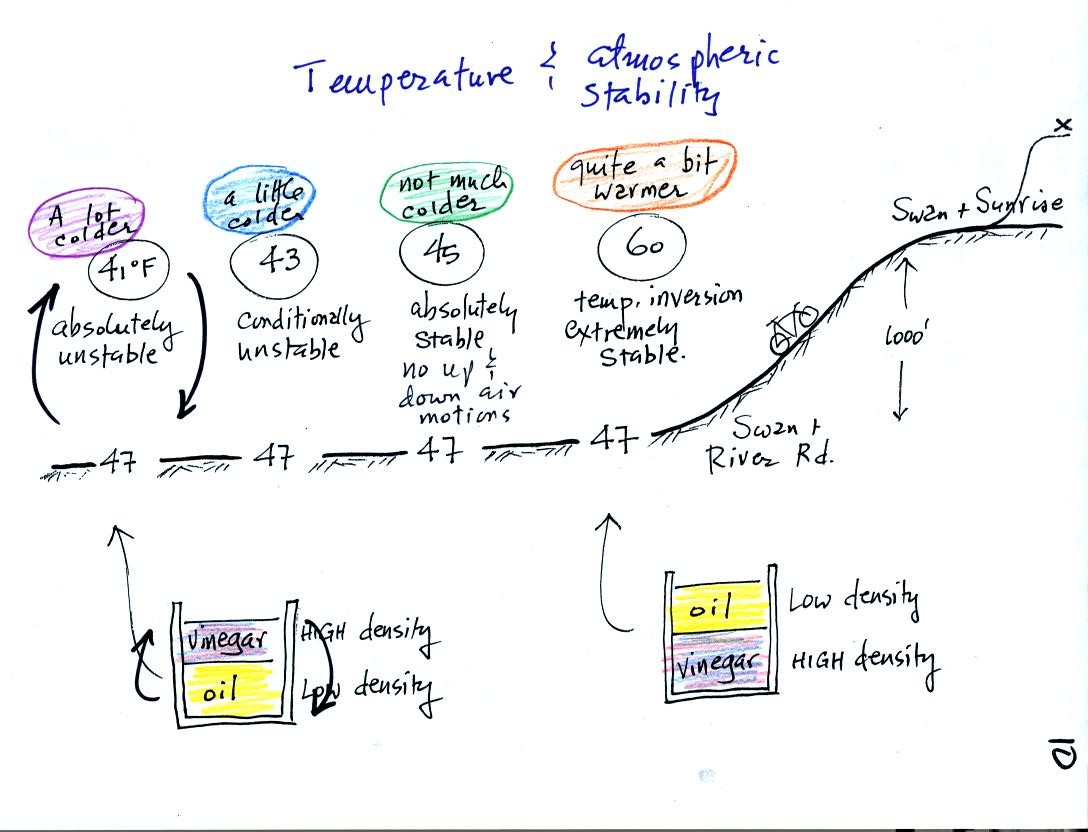
This rather
busy and confusing picture just illustrates how small changes in how
air temperature changes with increasing altitude can determine whether
the atmosphere will be stable or unstable. Just for the
purposes of illustration we imagine riding a bicycle from Swan and
River Rd up a hill to Swan and Sunrise (fhe figure shows an elevation
change of 1000 ft, it is actually quite a bit less than that)
At far left the air temperature drops 6o F. This is a
fairly
rapid drop with increasing altitude and would make the atmosphere
absolutely unstable. The atmosphere wouldn't remain this
way. Air at the ground would rise, air above would sink, and the
temperature profile would change. In some ways it would be like
trying to pour vinegar on top of oil in a glass. The lower
density oil would rise because it would "want" to float on top of the
higher density vinegar.
The next picture shows air temperature decreases a little more slowly
with increasing altitude. This small change makes the atmosphere
conditionally unstable (we won't go into the conditions). The
atmosphere is frequently in this state.
The atmosphere cools only 2o F in the next picture.
This creates
an absolutely stable atmosphere. Air at the ground will remain at
the ground and won't rise and mix with air higher up. Compare
this with the glass containing vinegar and a layer of oil on top.
The two layers won't mix.
Air temperature in the last figure actually increases with increasing
altitude, common on winter mornings in Tucson (and worth bicycling up
the hill on Swan Rd. just to experience on a cool winter morning).
This is a temperature inversion and produces very
stable conditions. If you do find yourself on a bicycle at
Swan and Sunrise, check out the very steep portion at the far northern
end of Swan.
Next we
will turn our attention to ozone.
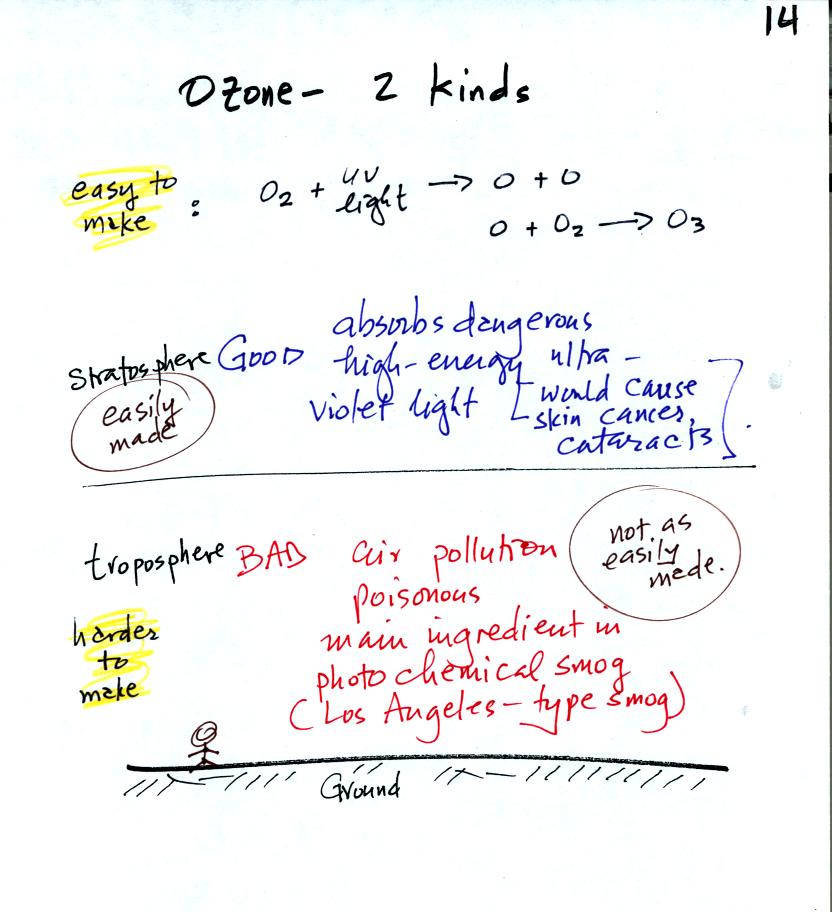
Ozone has a Dr. Jekyll and Mr. Hyde personality.
Ozone in the stratosphere is beneficial, it absorbs dangerous high
energy ultraviolet light (which would otherwise reach the ground and
cause skin cancer, cataracts, and many other problems).
Ozone in the troposphere is bad, it is a pollutant.
Tropospheric
ozone is also a key component of Los Angeles type or photochemical smog.
We'll eventually be making some photochemical smog as a
class
demonstration. This will require ozone (and a hydrocarbon of some
kind). We'll use the simple stratospheric process for making
ozone in the demonstration rather than the more complex tropospheric
process.
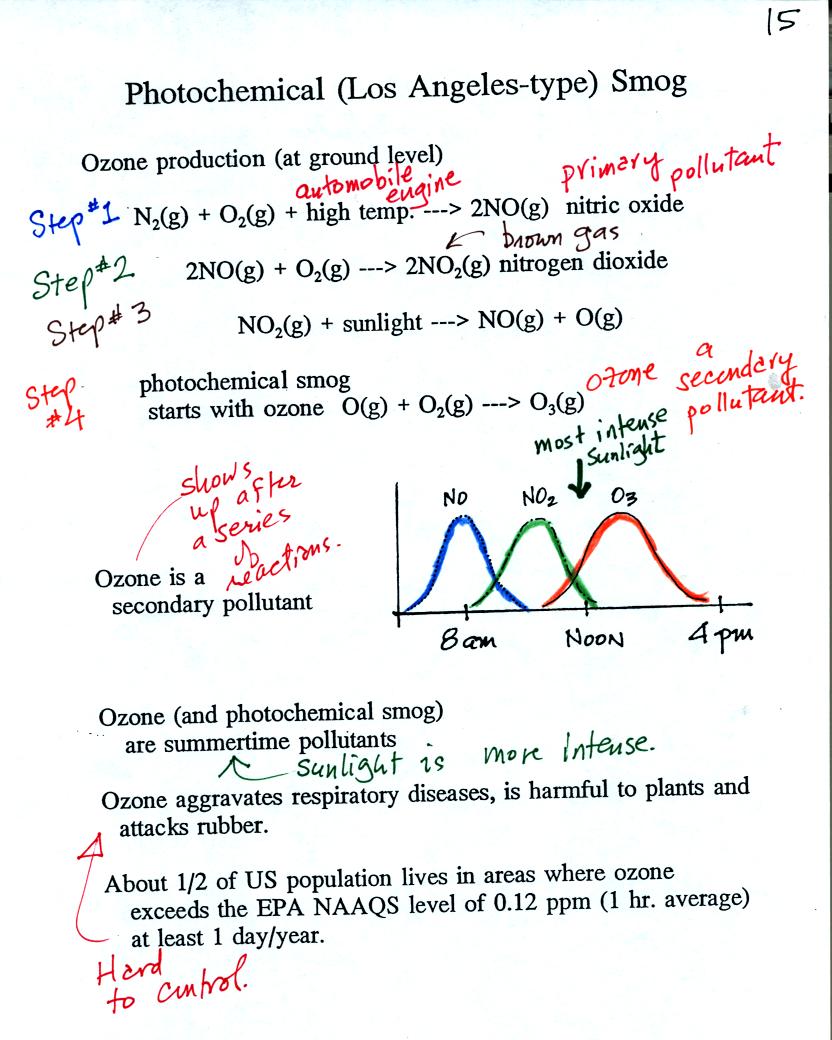
At the top of this figure you see that a more complex series
of
reactions is responsible for the production of tropospheric
ozone. The production of tropospheric
ozone begins with nitric
oxide
(NO). NO is produced when nitrogen and oxygen are heated (in an
automobile engine for example) and react. The NO can then react
with oxygen to make nitrogen dioxide, a poisonous brown-colored
gas. Sunlight can dissociate (split) the nitrogen dioxide
molecule producing atomic oxygen (O) and NO. O and O2
react (just
as they do in the stratosphere) to make ozone (O3).
Because ozone
does not come directly from an automobile tailpipe or factory chimney,
but only shows up after a series of reactions, it is a secondary
pollutant. Nitric oxide would be the primary pollutant in
this example.
NO is produced early in the day (during the morning rush hour).
The concentration of NO2
peaks
somewhat later. Peak ozone concentrations are usually found in
the afternoon. Ozone concentrations are also usually higher in
the summer than in the winter. This is because sunlight plays a
role in ozone production and summer sunlight is more intense than
winter sunlight.
As shown in the figure below,
invisible ozone can react with a hydrocarbon of some kind which is also
invisible to make a
product
gas. This product gas sometimes condenses to make a visible smog
cloud or haze.
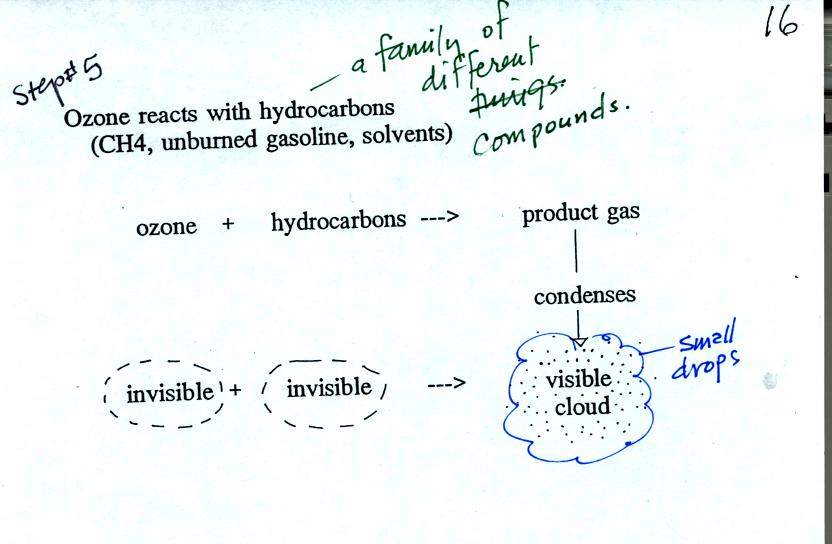
The class demonstration of photochemical smog is summarized
below (a flash was used instead of the aquarium shown on the bottom of
p. 16 in the photocopied class notes). We begin by using the UV
lamp to fill the flask with
ozone. Then a few pieces of fresh lemon peel were added to the
flask. A whitish cloud quickly became visible (colored brown in
the figure below).
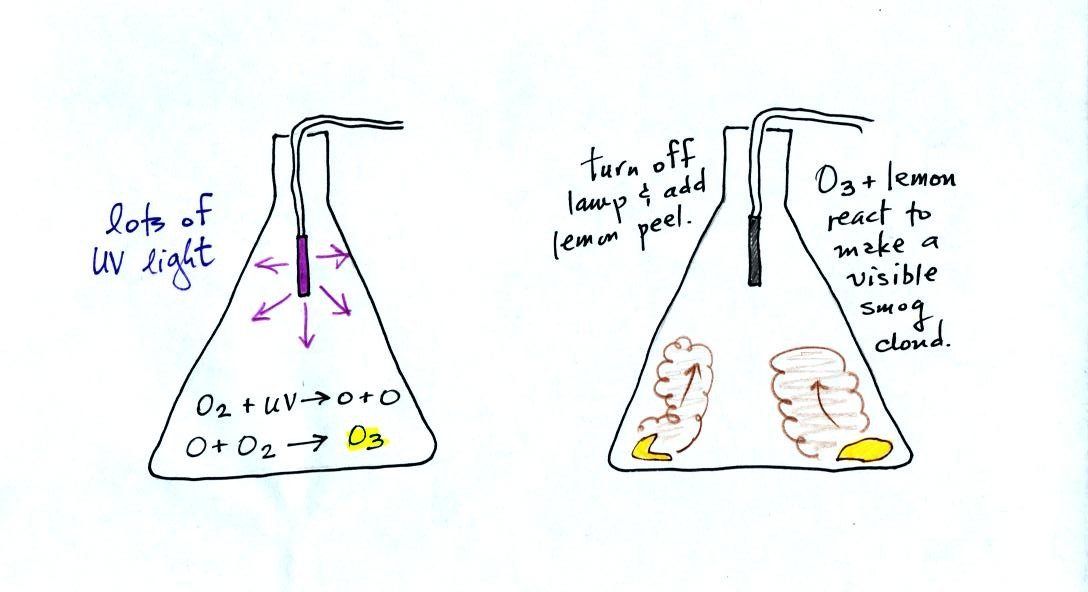
Sulfur
dioxide was covered briefly in class (we may come back to this on
Thursday).

Sulfur dioxide is produced by the combustion of sulfur
containing
fuels such as coal. Combustion of fuel also produces carbon
dioxide and carbon monoxide. People probably first became aware
of sulfur dioxide because it has an unpleasant smell. Carbon
dioxide and carbon monoxide are odorless.
Volcanoes are a natural source of sulfur dioxide.
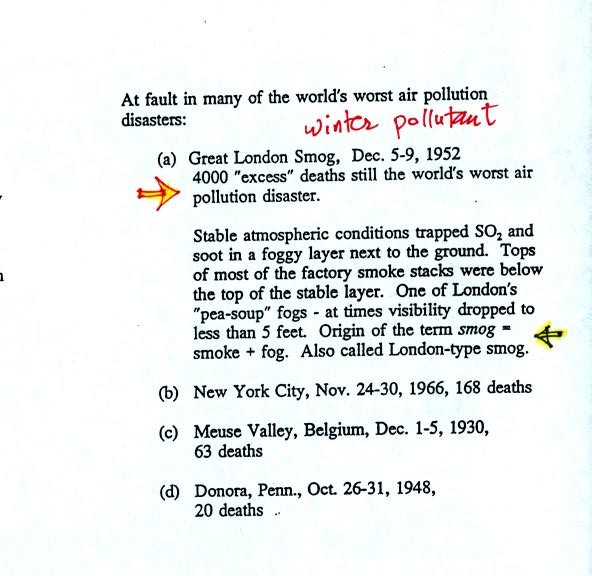
The Great London smog is still the deadliest air pollution
event in
history. Because the atmosphere was stable, SO2
emitted into air
at ground level couldn't mix with cleaner air above. The SO2
concentration was able to build to dangerous levels. You'll find
the Donora, PA, disaster described in more detail on p. 346 in the text.
London type smog which contains sulfur dioxide and is most common
during the winter is very different from photochemical or Los Angeles
type smog. Los Angeles type smog contains ozone and is most
common in the summer.
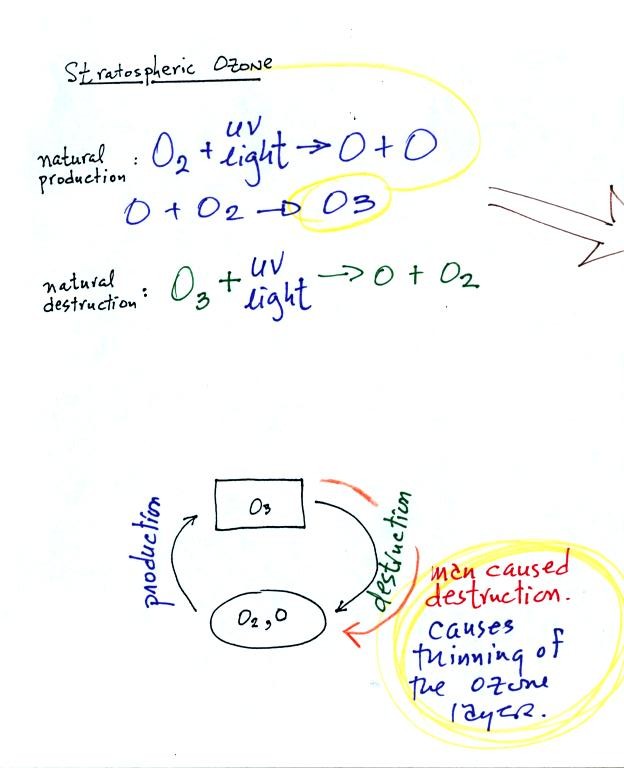
Stratospheric ozone forms naturally when UV light splits
oxygen
molecules (O2) into two oxygen atoms
(photodissociation). The O atoms can
then react
with unsplit O2 to make O3 ozone. The figure
above and the figure below are found on p. 17 in the photocopied
classnotes.
One way in which is destroyed naturally are shown in the figure
above. The ozone molecule is destroyed when it absorbs UV
light.
Once you understand how stratospheric ozone is formed you can
appreciate why the peak concentrations (the ozone layer) are found not
at the bottom or
top of the atmosphere but at some level in between (at around 25 km),
where there are optimal amounts of oxygen and UV
light.

There is lots of UV light above 25 km but not much oxygen. There
is plenty of oxygen below 25 km but not enough UV light. The
optimum amounts of both ingredients are found near 25 km.
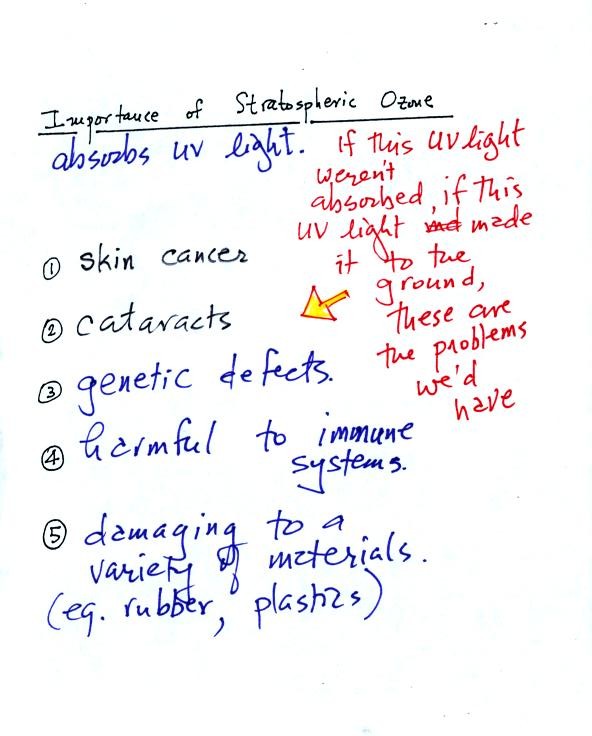
Stratospheric ozone, the ozone layer, absorbs much (but not
all) of the dangerous high energy ultraviolet light from the sun.
Listed above are some of the serious hazards or problems associated
with exposure to ultraviolet light. This is about as far as we were able to
get in class.
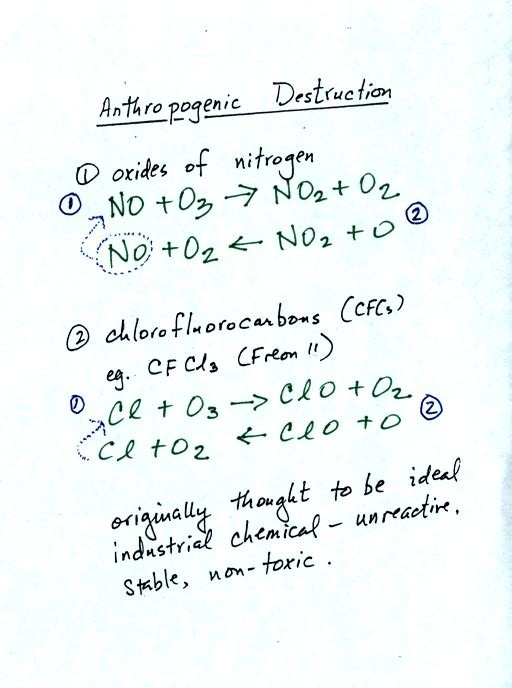
The figure above wasn't
shown in class.
Human activities add substances to the atmosphere that can
potentially
reduce ozone concentration in the ozone layer (which would result in
increased exposure to UV light at the ground).
The first set of reactions above involve nitric oxide, NO. First,
NO reacts with O3 to form NO2 and O2 (ordinary molecular oxygen).
Then notice the NO2 reacts with an oxygen atom (which might otherwise
react with O2 to make O3) to form NO again and O2. The NO is available
again to react with and destroy another ozone molecule.
At one time many countries were considering building fleets of
supersonic aircraft that would fly into the stratosphere. The
plans were scrapped partly due to concern that the NO emissions from
these aircraft would damage the ozone layer.
Chlorofluorocarbons now probably represent the greatest threat to the
ozone layer. Free chlorine (Cl from a CFC molecule) reacts with
ozone to form chlorine monoxide (ClO). The ClO reacts with an
oxygen atom and to O2 and Cl. The free chlorine is available to react
again and destroy another ozone molecule. It is thought
that a single Cl atom could destroy 100,000 ozone molecules before
being removed from the stratosphere.
Answer to the question found earlier in
the notes:
The air in high altitude cities is thinner (less dense) than at lower
altitude. There isn't as much oxygen in a volume of air.
With oxygen in short supply, combustion of fuels will more likely be
incomplete and will produce CO rather than carbon dioxide.















